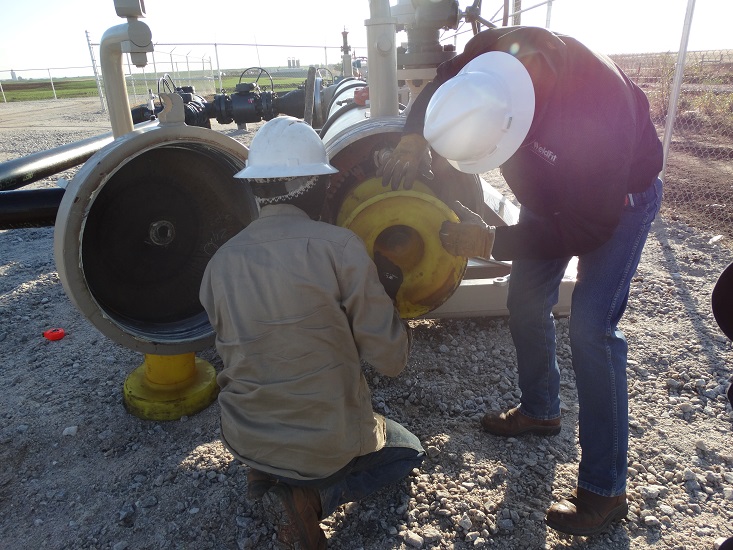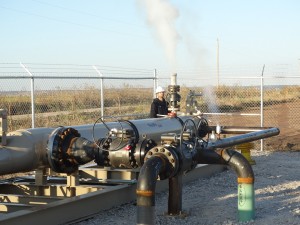February 2016, Vol. 243, No. 2
Features
Automated Pigging Systems Prove Proficient in Savings, Energy Efficiencies

Pigging systems are installed on pipeline systems for the purpose of inserting a pipeline pig into the pipe without interruption of the pipeline flow. Pipeline pigs are typically sized to the nominal pipeline diameter and configured of different designs and materials to serve the purpose of cleaning, liquid removal, drying, batching, chemical treatment or inline inspection.
Automated pigging systems refer to a method and system for staging multiple pigs and launching a single pig with a fully, semi or manually operated automated system. Automated pigging systems can be utilized to perform four separate pigging functions: liquid recovery, cleaning, batching and inline inspections. Horizontally oriented launcher designs are loaded with multiple pigs in one loading operation that allows the launching of a single cleaning pig, batching pig or spherical pig for both liquid and gas pipeline service applications.
Improved Flow Efficiency
Flow efficiency has been one of the primary factors motivating the decision for operators to develop economic justification to utilize automated pigging systems. Many operating companies, primarily natural gas operators, have begun flow modeling of their pipeline systems with various software programs that are available. Their intent is to determine the volume of NGL liquids that have condensed or accumulated in their pipeline systems to determine the necessary capacity of a slug catcher or to size temporary tank volumes for theoretical pigging operations.
Many operators are implementing “time-based” pigging programs where increased differential pressures, pipeline hydraulics and flow rates are not taken into consideration when establishing pigging frequencies. Ideally, the initial pressure drop as a pipeline is placed into service is established and compared to the actual pressure drops that are being exhibited from point to point along the pipeline system.
Pressure drops are created by many factors such as surface roughness, fluid density, fluid viscosity, friction factor, debris and flow type. However, low flow inefficiencies are typically identified through a decrease in throughput. The primary cause of throughput decrease is an internal diameter restriction because of debris such as paraffin, corrosion byproducts, frac sand, chlorides and sulfur. It is sometimes possible to overcome the bore diameter restriction by increasing the compressor or pump horsepower outputs.
Determining the cost savings based on flow efficiency can be performed in several different manners as a result of pigging:
- Increased throughput and revenue as a result of a percentage flow efficiency increase.
- Increased throughput and revenue as a result of the removal of debris wall buildup based on thickness.
- Increased throughput and revenue as a result of increased compressor/pump efficiency and fuel costs to operate compressors or pumps.
 Each operator must determine the method that best fits their operations for managing flow efficiency costs since different factors such as wall thickness, theoretical maximum flow rate or transportation rates can affect the outcome of the results. For example, a 12-inch pipeline flowing 50,000 bpd using a transportation rate of $1.25/barrel in which the throughput is increased 2% would result in an increase of 230 bpd or $2,875 in additional daily revenue. Whereas, the economics for the same pipeline system with different economic factors may yield higher flow efficiency based on a reduction of the total operating costs of the compressor or pump to transport the product.
Each operator must determine the method that best fits their operations for managing flow efficiency costs since different factors such as wall thickness, theoretical maximum flow rate or transportation rates can affect the outcome of the results. For example, a 12-inch pipeline flowing 50,000 bpd using a transportation rate of $1.25/barrel in which the throughput is increased 2% would result in an increase of 230 bpd or $2,875 in additional daily revenue. Whereas, the economics for the same pipeline system with different economic factors may yield higher flow efficiency based on a reduction of the total operating costs of the compressor or pump to transport the product.
With this scenario, the fluid density, elevation profile, decrease in pressure drop due to pigging, flow velocity and power consumption must be considered to determine the reduction in operating costs. Ultimately, an operator can determine the total cost of an outage as a result of an unintentional release due to internal corrosion that may be controlled by routine maintenance pigging.
Operating, Maintenance Costs
The reduction of labor costs, shortage of experienced personnel and access to remote locations are some of the primary economic factors that operators consider to justify the use of automated pigging systems. Many operators may require pigging operations multiple times daily especially in colder environments where more liquids are typically condensed from high Btu gas streams or paraffin become more solidified.
Dedicated pigging personnel for 24-hour operations may exceed a cost of $5,000 per day, depending on the geographic location. The installation of an automated pigging system reduces the overall labor costs in proportion to the total number of pigs that the launcher barrel can carry and the pigging frequency that is employed. In many instances, access to remote launcher and receiver locations factor into the justification to whether automated pigging systems are used.
Preventative measures are often attempted to prevent pipe buildup by paraffin. Some operators are spending a tremendous amount of money on chemicals to keep the paraffin suspended in the crude oil just to allow them to pig their lines or attempt to maintain flow. In other cases, operators are using hot oilers to improve the flow of paraffin-contaminated crude oil to allow them to be pigged. The use of hot oilers has sometimes caused damage to the external pipe-coating system as well as damage to pigs. Even though hot oilers are not very effective in removing paraffin beyond the first half mile of application, they are still being used.
During pigging operations on natural gas pipelines, traditional launcher and receiver systems are depressurized during the launching and receiving of single pigs, thereby releasing methane emissions. Many operators are flaring the blowdown gas while depressurizing the system. However, the volume of gas that is discharged must be accounted for as part of the operator’s gain/loss process. The total volume of methane that is emitted is directly proportional to the line, barrel size and line pressure.
The use of an automated pigging system would reduce the methane emission volumes based on the total number of pigs that can be staged and launched. However, automated pigging systems that utilize supply gas pneumatics to activate their launch mechanism may be a potential source of fugitive emissions.
Safety
Automated pigging systems that have the capability to stage and load multiple pigs (typically 7 to 10 at a time) substantially reduce the risk of exposure to H2S during depressurizing of the launcher or receiver barrel during loading and unloading operations. The exposure risk is exponentially reduced by the number of pigs that are loaded and launched after depressurizing the launching and receiving system just one time.
Pigging systems in general are exposed to cyclic fatigue due to the repeated applied loading and unloading that occurs during traditional launching and receiving activities. The pigging system is exposed to full pressure cycles (atmospheric pressure to the normal operating pressure) as opposed to the pipeline system that operates at a relatively constant pressure.
Again, the likelihood of failure due to cyclic fatigue is substantially reduced by the use of an automated pigging system equipped with a flow-through barrel. The flow-through barrel maintains a relatively constant operating pressure for a much longer period of time and staging of multiple pigs reduces the number of cycles that the system is exposed.
Pyrophoric substances such as iron sulfide auto-ignite in the presence of oxygen in an extremely exothermic reaction. In many situations when the presence of iron sulfide is known or suspected, special precautions such as nitrogen purging or flooding the barrel with water during pig-receiving operations are employed to improve safety-handling procedures. The installation of an automated pigging system equipped with multi-pig staging and launching capabilities would reduce the safety pyrophoric auto ignition risk of personnel, handling, and disposal costs.
Conclusions
- Safety considerations must be taken into account to determine the applicability of automated pigging systems.
- Economic factors such as flow efficiency, labor costs and internal corrosion mitigation must be considered for selecting the use of automated pigging systems over traditional pigging systems.
- The selection of an automated pigging system type should meet the intended goals of the pigging operations.
- Capital expenditure and installation costs must be considered for automated pigging systems vs. traditional pigging systems.
Written by David Wint, Director of Pipeline Integrity, Audubon Field Solutions
 Author: David Wint is the director of Pipeline Integrity for Audubon Field Solutions. He has over 30 years of technical pipeline experience in the oil and gas industry. He specializes in corrosion control, pipeline integrity, regulatory compliance, and pipeline pigging programs. In his current role, Wint leads the pipeline integrity operations efforts. He earned a bachelor’s degree in mechanical engineering from the University of Tulsa and is a certified NACE (National Association of Corrosion Engineers) CP (Cathodic Protection) Specialist.
Author: David Wint is the director of Pipeline Integrity for Audubon Field Solutions. He has over 30 years of technical pipeline experience in the oil and gas industry. He specializes in corrosion control, pipeline integrity, regulatory compliance, and pipeline pigging programs. In his current role, Wint leads the pipeline integrity operations efforts. He earned a bachelor’s degree in mechanical engineering from the University of Tulsa and is a certified NACE (National Association of Corrosion Engineers) CP (Cathodic Protection) Specialist.






Comments